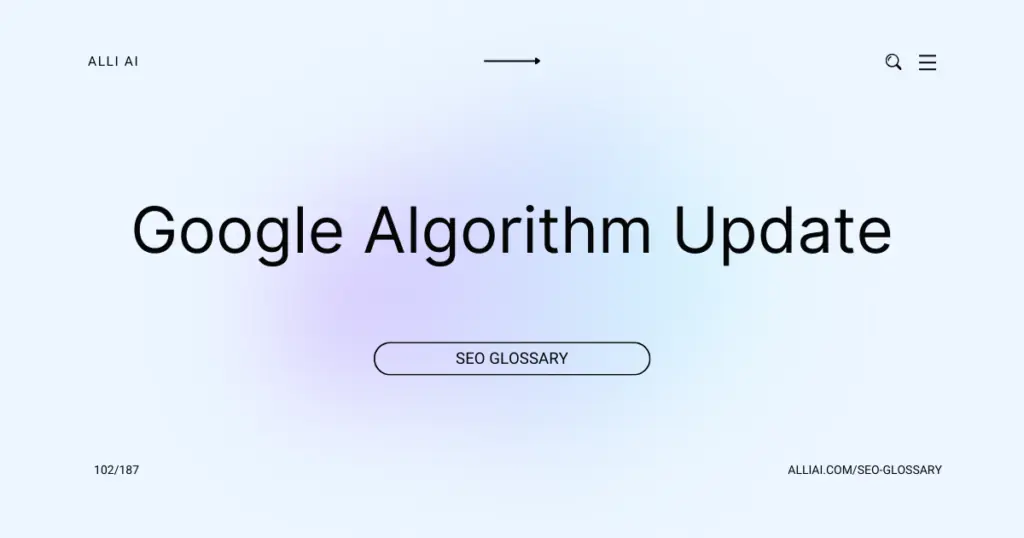What Does Google Algorithm Update Mean?
The Google Algorithm Update refers to changes and improvements made by Google to its search engine algorithms, which determine how websites are ranked in search results. These updates aim to enhance the relevance, accuracy, and quality of the results, ensuring users find the most useful and appropriate content for their queries.
Where Does Google Algorithm Update Fit Into The Broader SEO Landscape?
Google algorithm updates are crucial in the SEO landscape as they directly influence how websites are ranked in search engine results pages (SERPs). These updates refine and adjust Google’s criteria for evaluating relevance, authority, usability, and content quality, aiming to improve user experience and provide the most accurate and helpful information. SEO strategies must adapt to align with these updates to maintain or enhance website visibility and ranking. Frequent changes in the algorithm, such as Panda, Penguin, and BERT, shift SEO priorities and techniques, emphasizing the need for website optimization, high-quality content, mobile-friendliness, and user-focused performance metrics. This ongoing evolution ensures that SEO remains dynamic, requiring marketers to stay informed and responsive to changes in Google’s search algorithms.
Real Life Analogies or Metaphors to Explain Google Algorithm Update
1. Google Algorithm Update as a Recipe Tweak: Imagine your favorite cookie recipe. One day, you decide to tweak the recipe a bit to improve the texture or flavor, perhaps by adjusting the amount of sugar or baking a bit longer. Similarly, Google updates its algorithms to fine-tune the way it delivers search results, aiming to enhance the relevance and quality of the information it serves up.
2. As a Gardener Pruning a Tree: Think of Google as a gardener and its algorithm as a large, sprawling tree. Every now and then, the gardener prunes the tree to keep it healthy and ensure it grows in the desired direction. These prunings are the updates that help eliminate irrelevant or low-quality content, allowing the most useful and relevant pages to flourish.
3. As a Librarian Reorganizing Shelves: Imagine a librarian noticing that certain books are frequently misfiled, making it hard for patrons to find what they need. In response, the librarian reorganizes the shelves, perhaps introducing a new filing system that considers the latest trends in book searches. Google’s algorithm updates work in a similar way, continuously refining how information is indexed and retrieved to improve user experience.
4. As Referee Changing Sports Rules: Consider how sports rules are occasionally updated to ensure fair play and enhance the game’s enjoyment for fans and players alike. Google updates its algorithms similarly, changing the ‘rules’ websites must follow to rank well in search results. This ensures that the ‘game’ of search remains fair, rewarding those who provide the most value.
5. As Tuning a Musical Instrument: Imagine a musician tuning their instrument before a concert to ensure it produces the best sound quality. Google’s algorithm updates are like this tuning process, adjusting various ‘strings’ or ‘parameters’ to ensure that users receive the most harmonious and relevant search results possible.
How the Google Algorithm Update Functions or is Implemented?
1. Pre-Update Data Collection: Google constantly gathers data on search practices and results’ effectiveness. Metrics like click-through rates, time spent on page, bounce rates, and mobile usability are closely monitored.
2. Experimental Algorithms: Before a major update, Google tests new algorithms in a controlled environment or sometimes live with a small subset of users. This helps determine the potential impact of changes.
3. Announcement of Changes: Google announces major algorithm changes but typically does not divulge specifics in order to prevent manipulation of search results. However, they may provide general guidance on what the update is meant to enhance or address.
4. Rollout of Updates: Updates are rolled out, which can either be global or regional, and are implemented server-side. This can take days or weeks to be fully active across all regions.
5. Monitoring and Feedback Analysis: Post-update, Google monitors the changes’ effects on search quality and user behavior. Feedback from webmasters and SEO communities is also considered.
6. Adjustments and Tweaks: Based on the monitoring and feedback, further adjustments may be made to refine search results and address any unintended consequences. These subsequent tweaks can sometimes be as impactful as the original update.
7. Continuous Updates: Google continually updates its algorithms, often deploying small and incremental changes that go unnoticed by the majority of users but help to continuously improve the search results and experience.
Impact Google Algorithm Update has on SEO
Google Algorithm Updates significantly impact a website’s SEO performance and rankings by altering how search engines evaluate and prioritize web content. These updates can shift a website’s visibility on search engine results pages (SERPs) either positively or negatively based on the site’s adherence to the new standards set by the update. Common factors affected include the relevance and quality of content, the use of keywords, mobile-friendliness, page speed, user interaction data (like dwell time and bounce rates), and the quality of backlinks.
For user experience, these updates often promote enhancements by prioritizing websites that offer a more efficient, secure, and user-friendly interface. Sites that are easily navigable, load quickly on all devices, and provide high-quality, engaging content are favored, leading to potentially higher ranks in SERPs. Conversely, websites that provide a poor user experience tend to drop in rankings post-update. Thus, keeping abreast of these updates and optimizing websites accordingly is crucial for maintaining or improving SEO performance and user engagement.
SEO Best Practices For Google Algorithm Update
1. Identify the specific focus of the Google Algorithm Update (e.g., page speed, mobile-friendliness, content quality).
2. Conduct a site audit to measure current performance related to the update’s focus area; use tools like Google Analytics, Google Search Console, and specialized SEO tools like Ahrefs or SEMrush.
3. For updates focusing on content quality:
– Evaluate the relevancy and depth of your content.
– Improve content quality by addressing E-A-T (Expertise, Authoritativeness, Trustworthiness) principles.
– Ensure content is original, well-researched, and provides real value to users.
– Update or remove outdated, duplicated, or thin content.
4. For updates targeting page experience:
– Use Google’s Core Web Vitals report to identify issues in loading performance, interactivity, and visual stability.
– Optimize image sizes and use next-gen formats.
– Minimize JavaScript and CSS.
– Implement lazy loading for images and non-critical resources.
– Ensure mobile-friendliness of all pages.
5. For updates focusing on user engagement signals:
– Improve user interface and user experience design.
– Simplify navigation to ensure that important content is easily accessible.
– Enhance calls to action and page interactivity.
6. Adapt to changes in technical SEO if the update affects how Google interprets site data:
– Ensure proper use of schema markup.
– Check and optimize the robots.txt file and XML sitemaps for proper crawling and indexing.
– Leverage canonical tags to avoid duplicate content issues.
7. Build and maintain a healthy backlink profile if the update affects link evaluation:
– Audit your existing links using tools like Majestic or Ahrefs.
– Disavow toxic or spammy links through Google Search Console.
– Implement a strategy for acquiring high-quality, relevant links.
8. Continuously monitor site traffic and rankings after implementing changes using Google Search Console and other SEO monitoring tools.
9. Stay updated with any new information or detailed guidance provided by Google or from reputable SEO sources regarding the update.
10. Be prepared to make additional adjustments based on ongoing observations and insights related to the update’s impact on your site.
Common Mistakes To Avoid
1. Ignoring Mobile Optimization:
– Ensure websites are mobile-friendly.
– Use responsive design techniques.
2. Poor User Experience (UX):
– Improve site speed.
– Enhance navigational structure.
3. Non-Compliance with E-A-T (Expertise, Authoritativeness, Trustworthiness):
– Highlight credentials of content creators.
– Secure backlinks from reputable sites.
4. Overlooking Content Quality:
– Focus on producing original, useful content.
– Regularly update existing content.
5. Keyword Stuffing:
– Employ natural language in content.
– Use keywords contextually.
6. Neglecting Structured Data & Schema Markup:
– Implement structured data markup.
– Regularly test schema with Google’s tools.
7. Inadequate Link Building Practices:
– Aim for quality over quantity in backlinks.
– Avoid buying links and participate in link schemes.
8. Ignoring Local SEO:
– Optimize for local search queries.
– Maintain up-to-date local business listings.
9. Not Adapting to Voice Search:
– Optimize for conversational keywords.
– Include question-based content.
10. Lack of Social Media Integration:
– Encourage content sharing on social platforms.
– Integrate social media on the website.
11. Missing Out on Video Content:
– Utilize video for engagement and retention.
– Optimize video titles and descriptions for search.
12. Forgetting Image Optimization:
– Compress images for faster loading.
– Use descriptive filenames and alt text.






